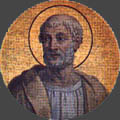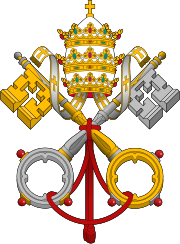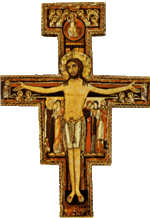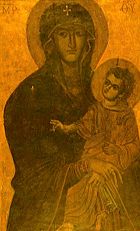Pope Clement I
| Saint Clement I | |
 |
|
| Papacy began | c. 92 |
|---|---|
| Papacy ended | c. 99 |
| Predecessor | Anacletus |
| Successor | Evaristus |
| Born | 1st century AD Rome, Roman Empire |
| Died | traditionally 99 or 101 Chersonesus, Taurica, Bosporan Kingdom (modern-day Crimea, Ukraine) |
| Other popes named Clement | |
Pope Saint Clement I (fl 96),[1] also known as Saint Clement of Rome (in Latin, Clemens Romanus), is considered by some to be the fourth Pope and Bishop of Rome.[2] He was the first Apostolic Father of the early Christian church.[3]
Few details are known about Clement's life. According to Tertullian Clement was ordained by Saint Peter,[3] and he is known to have been a leading member of the church in Rome in the latter part of the 1st century. Early church lists place him as the second or third[4][5] bishop of Rome after Saint Peter, but the meaning of this evidence is unclear.[4] While there were presbyter-bishops as early as the first century,[6] "there is no evidence for monarchical episcopacy in Rome at so early a date".[4]
St Clement's only genuine extant writing is his letter to the Corinthian church, 1 Clement (c 96), which was a response to strife in the Corinth church, where certain presbyters had been deposed.[4] He asserted the authority of the presbyters as rulers of the church, on the grounds that the apostles had appointed them.[4] It was read in church, along with other epistles, some of which would later become Christian canon; and is one of the oldest Christian documents still in existence outside the New Testament. This important work is the first to manifest Rome's primacy and the first to affirm the apostolic authority of the church fathers.[7]
A second epistle, 2 Clement, was attributed to Clement although recent scholarship suggests it to be a homily by another author.[4] In the legendary Clementine Literature, Clement is the intermediary through whom the Apostles teach the church.[4] According to a tradition not earlier than the 4th century, Clement was imprisoned under the Emperor Trajan but nonetheless led a ministry among fellow prisoners. He was then executed by being tied to an anchor and thrown into the sea.[4]
Clement is recognized as a saint in many Christian churches. He is commemorated on November 23 in the Roman Catholic Church, the Anglican Communion, and the Lutheran Church.[8] In Orthodox Christianity his feast is kept on November 24 or November 25.
Contents |
Life
| Papal styles of Pope Clement I |
|
|
|
|
| Reference style | His Holiness |
| Spoken style | Your Holiness |
| Religious style | Holy Father |
| Posthumous style | Saint |
Clement is known for his epistle to the church in Corinth (c 96), in which he asserts the apostolic authority of the bishops/presbyters as rulers of the church.[4] He uses the terms bishop and presbyter interchangeably for the higher order of ministers above deacons.[4]
Early succession lists name Clement as the first,[9][10] second or third[4][11] bishop of Rome after Saint Peter. However, as there is no evidence for monarchical episcopacy in Rome at that time, the meaning of his inclusion in these lists is unclear.[4]
Starting in the 3rd and 4th century,[4] tradition has identified him as the Clement that Paul mentioned in Philippians 4:3 as a fellow laborer in Christ.[12] In the 19th century he was identified as a freedman of Titus Flavius Clemens, who was consul with his cousin, the Emperor Domitian, but no ancient sources suggest this identification and it is likely false.[3] The 2nd-century Shepherd of Hermas mentions a Clement whose office it is to communicate with other churches.[13]
The "Liber Pontificalis," which documents the reigns of popes states that Clement had known Saint Peter. It also states that he wrote two letters (though the second letter, "2 Clement" is no longer ascribed to him) and that he died in Greece in the third year of Emperor Trajan's reign, or 101 AD.
Rome
The Roman congregation of Clement's day was large and influential. A large congregation existed here c 58, when Paul wrote his Epistle to the Romans. Paul arrived in Rome c 60 (Acts). His Captivity Epistles, as well as Mark, Luke, Acts, and 1 Peter were written here, according to many scholars. Paul and Peter were said to have been martyred here. Nero persecuted Roman Christians after Rome burned in 64, and the congregation may have suffered further persecution under Domitian (81-96). Clement was the first of early Rome's most notable bishops.[14]
Bishop
Clement's epistle mentions episkopoi (superintendents, bishops) or presbyteroi (elders, presbyters), as the upper class of minister, served by the deacons, but, since it does not mention himself, it gives no indication of the title or titles used for Clement in Rome.
New Testament evidence about the episcopate is inconclusive, but it seems to indicate that at first the two terms, "bishop" and "presbyter", were used interchangeably. For Ignatius of Antioch, who died in the early years of the second century, bishops and presbyters were already quite distinct. Elsewhere, particularly in Egypt, the distinction seems to have become established only later. But by the middle of that century all the leading Christian centres had bishops.[15]
Writings
Epistle of Clement
Clement's only existing, genuine text is a letter to the Christian congregation in Corinth, often called the First Epistle of Clement or 1 Clement. The history of 1 Clement clearly and continuously shows Clement as the author of this letter. It is considered the oldest authentic Christian document outside of the New Testament.
Clement writes to the troubled congregation in Corinth, where certain "presbyters" or "bishops" have been deposed (the class of clergy above that of deacons is designated indifferently by the two terms).[4] Clement calls for repentance and reinstatement of those who have been deposed, in line with maintenance of order and obedience to church authority, since the apostles established the ministry of "bishops and deacons".[4] He mentions "offering the gifts" (the Eucharist) as one of the functions of the higher class of clergy.[4] The epistle offers valuable insight into Church ministry at that time and into the history of the Roman Church.[4] It was highly regarded, and was read in church at Corinth along with the Scriptures c. 170.[4]
Writings attributed to Clement
Second Epistle of Clement
The Second Epistle of Clement is a homily, or sermon, likely written in Corinth or Rome, but not by Clement.[4] Early Christian congregations often shared homilies to be read. The homily describes Christian character and repentance.[4] It is possible that the Church from which Clement sent his epistle had included a festal homily to share in one economical post, thus the homily became known as the Second Epistle of Clement.
While 2 Clement has been traditionally ascribed to Clement, most scholars believe that 2 Clement was written in the second century based on the doctrinal themes of the text and a near match between words in 2 Clement and in the Greek Gospel of the Egyptians.[16][17]
Epistles on Virginity
Two "Epistles on Virginity" were traditionally attributed to Clement, but now there exists almost universal consensus that Clement was not the author of those two epistles.
False Decretals
A ninth-century collection of church legislation known as the False Decretals, which was once attributed to Saint Isidore of Seville, is largely composed of forgeries. All of what it presents as letters of pre-Nicene popes, beginning with Clement, are forgeries, as are some of the documents that it attributes to councils (including the Donation of Constantine); and more than forty falsifications are found in the decretals that it gives as those of post-Nicene popes from Pope Sylvester I (314-335) to Pope Gregory II (715-731). The False Decretals were part of a series of falsifications of past legislation by a party in the Carolingian Empire whose principal aim was to free the church and the bishops from interference by the state and the metropolitan archbishops respectively.[18][19]
Clement is included among other early Christian popes as authors of the Pseudo-Isidoran (or False) Decretals, a 9th century forgery. This compilation documented an early history of the popes as the absolute and universal authority in the oldest traditions. Clement is the earliest pope included in the collection, and Melchiades (311-314) is the latest.[20]
Clementine Literature
St Clement is also the hero of an early Christian romance or novel that has survived in at least two different versions, known as the Clementine literature, where he is identified with Emperor Domitian's cousin Titus Flavius Clemens. Clementine Literature portrays Clement as the Apostle's means of disseminating their teachings to the Church.[4]
Martyrdom

According to a fourth century tradition, Saint Clement was banished from Rome during the reign of the Emperor Trajan.[3] He was sent to Chersonesus where he was sentenced to work with other prisoners in a stone quarry. Saint Clement arrived to find the prisoners suffering from a great lack of water. After kneeling down in prayer, the saint looked up to see a lamb standing upon a hill. Taking his pickaxe, Saint Clement went to where the lamb had stood and struck the ground, revealing a gushing stream of clear water.
In retaliation for this miracle and for having converted large numbers of the local pagans and his fellow prisoners to Christianity, Saint Clement was martyred by being tied to an anchor and thrown from a boat into the Black Sea. The traditional account of Saint Clement's martyrdom appears in a some apocryphal acta from the 4th century or later.[4]
Clement has traditionally been known as a martyr within the church although not all ancient sources (including Eusebius and Jerome) record that Clement was martyred.[21]
According to tradition, in the 9th century St. Cyril brought the relics of Saint Clement to Rome where they are now enshrined at the Basilica di San Clemente.[3] Other relics of Saint Clement, including his head, are claimed by the Kiev Monastery of the Caves in Ukraine.
Recognition as a Saint

St Clement's name is in the Roman Canon of the Mass. He is commemorated on November 23 as a Pope and Martyr in the Roman Catholic Church as well as within the Anglican Communion and the Lutheran Church. The Syriac Orthodox Church, the Malankara Orthodox Syrian Church and the Greek Orthodox Church, as well as the Syriac Catholic Church, the Syro-Malankara Catholic Church and all Byzantine Rite Eastern Catholic Churches, commemorate Saint Clement of Rome (called in Syriac "Mor Clemis") on November 24; the Russian Orthodox Church commemorates St Clement on November 25; and the Coptic Orthodox Church of Alexandria does so on December 8.
Symbolism
In works of art, Saint Clement can be recognized by having an anchor at his side or tied to his neck. He is most often depicted wearing the Papal vestments, including the pallium, and sometimes with the Papal tiara but more often with the mitre. He is also sometimes shown with symbols of his office as Pope and Bishop of Rome such as the Papal Cross and the Keys of Heaven. In reference to his martyrdom, he often holds the palm of martyrdom. Saint Clement can be seen depicted near a fountain or spring, relating to the incident from his hagiography, or lying in a temple in the sea. The Mariner's Cross is also referred to as St. Clement's Cross in reference to the way he was martyred.
References
- ↑ The "fl" abbreviation means "floruit," referring to when a person was active. The notation and year are from "Clement of Rome, St." Cross, F. L., ed. The Oxford dictionary of the Christian church. New York: Oxford University Press. 2005
- ↑ The 1908 Catholic Encyclopedia refers to him as "the fourth pope", i.e. the third after Saint Peter, but reports on several views on this question, and the 2008 Annuario Pontificio gives his dates as a "supreme pontiff of Rome" as either 92-99 (and so as the third successor of Saint Peter) or as 68-76 (and thus as St Peter's immediate successor).
- ↑ 3.0 3.1 3.2 3.3 3.4 Chapman, John. "Pope St. Clement I." The Catholic Encyclopedia. Vol. 4. New York: Robert Appleton Company, 1908. 6 Dec. 2008.
- ↑ 4.00 4.01 4.02 4.03 4.04 4.05 4.06 4.07 4.08 4.09 4.10 4.11 4.12 4.13 4.14 4.15 4.16 4.17 4.18 4.19 4.20 4.21 "Clement of Rome, St." Cross, F. L., ed. The Oxford dictionary of the Christian church. New York: Oxford University Press. 2005
- ↑ The Catholic Encyclopedia says that no critic now doubts that the names Cletus and Anacletus in lists that would make Clement the fourth successor of Saint Peter refer to the one person, not two.
- ↑ Van Hove, Alphonse. "Bishop." ;;The Catholic Encyclopedia. Vol. 2. New York: Robert Appleton Company, 1907. 6 Dec. 2008
- ↑ J. A. Tixeront, "Handbook of Patrology," St. Louis: B. Herder Book Co., 1920. [1]
- ↑ See Calendar of Saints (Lutheran)
- ↑ History of the Christian Church, Volume II: Ante-Nicene Christianity, AD 100-325 - "Clement of Rome"
- ↑ Like Schaff, the Holy See's Annuario Pontificio (Libreria Editrice Vaticana 2008 ISBN 978-88-209-8021-4), p. 7*, gives Clement as "supreme pontiff of Rome" in either 92-99 or 68-76, making him either the first or the third successor of Saint Peter, but not the second.
- ↑ The Catholic Encyclopedia article says that only on the false assumption that "Cletus" and "Anacletus" were two distinct persons, instead of variations of the name of single individual, did some think that Clement was the fourth successor of Saint Peter.
- ↑ "Writers of the 3rd and 4th cents., like Origen, Eusebius, and Jerome, equate him (St. Clement I), perhaps, correctly, with the Clement whom St. Paul mentions (Phil. 4:3) as a fellow worker." — Kelly (1985). "The Oxford Dictionary of Popes". Oxford University Press. pp. p. 7.
- ↑ "Vision II," 4. 3
- ↑ "Rome (early Christian)." Cross, F. L., ed. The Oxford dictionary of the Christian church. New York: Oxford University Press. 2005
- ↑ "bishop." Cross, F. L., ed. The Oxford Dictionary of the Christian Church. New York: Oxford University Press. 2005
- ↑ McBrien (2000). "Lives of the Popes". HarperCollins. pp. p. 35.
- ↑ Catholic Encyclopedia: "Pope St. Clement I"
- ↑ Encyclopaedia Britannica: False Decretals
- ↑ OSV's Encyclopedia of Catholic History: False Decretals
- ↑ Durant, Will. The Age of Faith. New York: Simon and Schuster. 1972. p. 525-526
- ↑ History of the Christian Church, Volume II: Ante-Nicene Christianity, AD 100-325 - "Clement of Rome"
Further reading
- Louise Ropes Loomis, "The Book of Popes" (Liber Pontificalis), Merchantville, NJ: Evolution Publishing. ISBN 1-889758-86-8 (Reprint of the 1916 edition. Stops with Pope Pelagius, (579-590). English translation with scholarly footnotes, and illustrations).
External links
- Catholic Encyclopedia: Pope St. Clement I
- Two Epistles Concerning Virginity .
- Opera Omnia
- Hieromartyr Clement the Pope of Rome Eastern Orthodox icon and synaxarion
- History of the Christian Church, Volume II: Ante-Nicene Christianity, AD 100-325 - Clement of Rome
- Patron Saints Index: Pope Saint Clement I
| Roman Catholic Church titles | ||
|---|---|---|
| Preceded by Anacletus |
Bishop of Rome Pope 88–101 |
Succeeded by Evaristus |
|
||||||||||||||||
|
|||||||||||||||||||||||||||||||||||||||||||||
|
|||||||||||||||||||||||||||||||||||||||||||||


